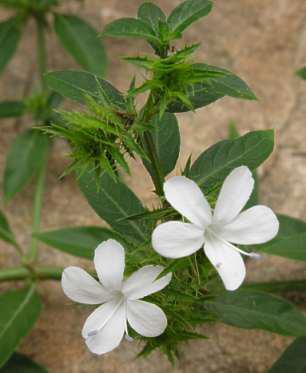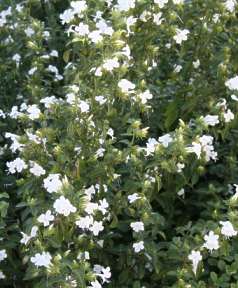Barleria elegans
Barleria elegans S.Moore ex C.B.Clarke
Family: Acanthaceae
Common names: white bushveld barleria ( Eng.); wit bosviooltjie (Afr.)
Introduction
Barleria elegans produces beautiful white flowers from February to July and is ideal to control erosion on embankments or for sunny areas in your garden.

Description
Description
Barleria elegans is a medium-sized, fairly fast-growing evergreen shrub up to 1 m high. The leaves are egg-shaped (ovate), dark green and much paler underneath. The narrowly funnel-shaped flowers are carried in few-flowered clusters in the axils (angle between the stem axis and leaf stem) and the bracteoles (reduced leaves) are spiny-toothed.
Conservation Status
Status
None.
Distribution and habitat
Distribution description
Barleria elegans is found in the summer-rainfall areas of South Africa where it grows in well-drained soils on rocky outcrops and hillsides in full sun to semi-shade and is able to withstand a moderate amount of frost. Rainfall ranges from 500-1000 mm per annum with temperatures rising into the thirties (°C).
Derivation of name and historical aspects
History
The name Barleria is derived from the name of a Dominican monk and French botanist, Jacques Barrelier, who lived during the 1600s. The species name elegans (Latin) means graceful. The genus consists of a group of herbs or shrubs, some producing spines and all producing fruit in the form of explosive capsules. Members of the genus occur from Japan in the far East, through southern Asia , India, Arabia, Africa, Madagascar to as far west as Central America and Mexico.
Ecology
Ecology
Barleria elegans is pollinated by insects and attracts various species of butterflies. The insects attract insectivorous birds; therefore this plant is a good choice for attracting life into the garden.
The fruit is a small capsule which explodes to release the seeds. The plant also carries spines to protect itself from being over-utilized by animals.
Uses
Use
Many species of Barleria would be a wonderful addition to any warm garden. An increasing number of other species such as B. obtusa, B. greenii, B albostellata and B. repens are now also found in cultivation.

Growing Barleria elegans
Grow
Barleria elegans grows under tropical, subtropical and relatively cold conditions and reaches maturity within two years. It can be propagated by through seed or from cuttings.
It grows easily from seed. Collect the fruit as soon as it turns brown, Don't wait too long to collect otherwise the capsules will explode and the seeds will be harder to collect or will be lost. Sow the seeds on the surface of a good soil, compost and sand mix in a ratio of 2:1:1, pressing them slightly into the surface. Place in 40% shade and water once a week with a fine sprinkler. Germination takes place after a week or two. Seedlings should be transplanted when they are about 200 mm high.
Take cuttings from partially matured wood, 60 mm long, using no. 2 hormone powder and a growing mixture of soil, compost and river sand in a ratio of 3:2:1. The ideal temperature for optimal root development is 15-28º C.
The plants require full sun to semi-shade and should be planted in sandy to loamy soils. Mix 500 g of compost with 50 g of superphosphate, working it into the soil to improve the growth of the plants. A moderate amount of water is required and these plants do rather well in the dry season, thus a perfect choice for a water-wise garden and the rehabilitation of disturbed areas. Plants are fast growing and need to be pruned back after the flowering season.
No known pests or diseases have been encountered.
References
- Pooley, E. 1998. A field guide to the wild flowers of KwaZulu-Natal and the Eastern Region. Natal Flora Publications Trust, Durban.
- Retief, E. & Herman, P.P.J. 1997. Plants of the northern provinces of South Africa : keys and diagnostic characters. Strelitzia 6.
- Thiselton-Dyer,W.T. (ed.). 1900. Flora of tropical Africa 5: 154. Lovell Reeve, London.
Credits
Willem Froneman & Lou-Nita Le Roux
Lowveld National Botanical Garden
November 2007
Plant Attributes:
Plant Type: Shrub
SA Distribution: KwaZulu-Natal, Limpopo, Mpumalanga
Soil type: Sandy, Loam
Flowering season: Late Summer, Autumn
PH: Neutral
Flower colour: White
Aspect: Full Sun, Afternoon Sun (Semi Shade)
Gardening skill: Easy
Special Features:
Horticultural zones









Rate this article
Article well written and informative
Rate this plant
Is this an interesting plant?
Login to add your Comment
Back to topNot registered yet? Click here to register.